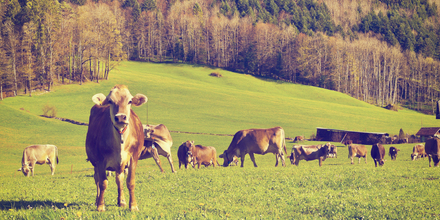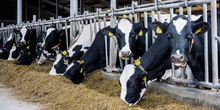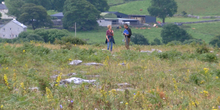Agriculture & Land Management
Our Work
Latest in Agriculture & Land Management
-

The consequences of climate change for EU Agriculture: Follow up to the COP21 UN Climate Change conference
With its potential to reduce GHG emissions and increase CO2 removals, agriculture has a key role to play in the EU’s climate mitigation efforts, yet Member State action is lacking. As pressure on the sector to act increases, the development of a 2050 low-carbon and resilience roadmap for European agriculture would be one step towards putting the sector on a more ambitious trajectory towards the transformation required to achieve net zero emissions by 2050.
-
Agriculture and its role in meeting the EU’s climate commitments
Sector far from reaching its climate mitigation potential, with Member States placing more emphasis on climate adaptation
-
What contributions can agricultural emissions make to the proposed Effort Sharing Regulation?
New IEEP report finds the agriculture sector can significantly contribute to the EU’s climate commitments by reducing its non-CO2 emissions. It also finds these contributions can be delivered cost efficiently with environmental co-benefits without impacting production.
-
Towards sustainability: Future policies for European livestock
The CAP is failing to reward adequately those livestock farmers who produce public goods. Brexit and CAP reform are opportunities to do better.
-
Are Ecological Focus Areas delivering for biodiversity?
Ecological Focus Areas are intended to safeguard and improve biodiversity on arable farms in the EU. What evidence is there that they are actually delivering biodiversity on farmland?
-
Ecological Focus Areas – what are their impacts on biodiversity?
Ecological Focus Areas are intended to safeguard and improve biodiversity on arable farms in the EU. This IEEP study for EEB and BirdLife examined the evidence for potential biodiversity impacts on farmland, taking into account how the areas are being managed.
-
The PEGASUS project publishes its first Newsletter
Welcome to the first newsletter of the PEGASUS project! It provides information on the project’s progress to date and details on the 34 case studies currently underway in 10 EU countries examining how to ensure the improved delivery of public goods and ecosystem services in different farming and forestry situations.
-
Improving environmental financing via result-based agri-environment measures
A new article by IEEP explores the use of result-based agri-environment measures in the region of Baden-Württemberg, Germany. The study shows that result-based schemes can increase the environmental effectiveness and conditionality of the EU Common Agricultural Policy.
-
Learning the lessons from CAP greening
What is the most cost-effective way to encourage basic environmental management across the farmed countryside in the EU-28? Learning from experience to date in greening Pillar 1 of the CAP, this report considers a range of options to increase the environmental added value from greening.
-
A circular bio-economy in the European agriculture and forestry sectors
IEEP experts call for bridging the circular and bio-economy concepts, to support the transition of Europe’s land using sectors to a more resource efficient and sustainable future.
-
CAP greening: what are its environmental prospects?
A significant injection of money was agreed for ‘green’ farming practices under the recent CAP reform. This report examines the environmental impact these measures are likely to have on the ground and concludes that Member States’ implementation choices appear to have much diminished the chances of the greening measures delivering significant additional environmental benefits.
-
New PEGASUS website
Project website for EU research project PEGASUS goes live!
-
Results-based agri-environment schemes: new report and guidance handbook available
Are you interested in developing and implementing a results-based payment scheme for farmland biodiversity? Together with experts from across Europe, IEEP has produced a range of useful resources to guide the future development of results-based agri-environment schemes in the EU and beyond.
-
The Manual: Front pages
This is a chapter of IEEP’s Manual of European Environmental Policy. This chapter provides information on the authors, editors and editorial board involved in the Manual, as well as guidance on how to use it, and a brief outline of its content.
-
The Manual: Chapter 12 - Funding instruments
This is a chapter of IEEP’s Manual of European Environmental Policy. This chapter sets out the EU's main funding instruments that have environmental implications, including the European Agriculture funds, the European Fisheries Fund and the Structural and Cohesion funds.
-
The Manual: Chapter 13 - Sectoral policies
This is a chapter of IEEP’s Manual of European Environmental Policy. This chapter sets out the development of some of the most important links between EU environmental policy and other policy areas, such as agriculture, forestry, fisheries, transport, trade, and so on.
-
Whither the new Commission?
IEEP’s David Baldock gives his take on the new Commission in the latest edition of our newsletter. Read about how IEEP is raising ambition for the next EU climate and energy package, plus: priorities and policy options for a circular economy, payments for farmland biodiversity achievements, biodiversity proofing EU spending, and more.
-
Sustainable intensification of European agriculture
The concept of sustainable intensification has come into prominence in the context of global food security. This report defines what we mean by sustainable intensification, explains its global logic, discusses what it means for EU agriculture and exemplifies this in three case studies for soil performance, nutrient recycling and biodiversity.
-
High Nature Value farming throughout EU-27 and its financial support under the CAP
This study reviews Member States’ estimates of the extent of HNV farmland and use of RDP measures and the CMEF indicators, then identifies future priorities for CAP support for HNV farming and discusses the support opportunities under the reformed CAP. It offers detailed new evidence about the combined effect of Pillar 1 and Pillar 2 CAP payments on the economic and environmental viability of a typical HNV farming system in three Member States.
-
New report: High Nature Value Farming in the EU
Member States need to make the most of the opportunities under the new Common Agricultural Policy if the declines in HNV farming, critical for meeting our 2020 biodiversity targets, are to be halted.
Related
-

Debating the Future of The Common Agricultural Policy
The IEEP's platform to share thoughtful commentary and analysis on the future development of European agriculture and rural development policy.
Highlights
-

The consequences of climate change for EU Agriculture: Follow up to the COP21 UN Climate Change conference
With its potential to reduce GHG emissions and increase CO2 removals, agriculture has a key role to play in the EU’s climate mitigation efforts, yet Member State action is lacking. As pressure on the sector to act increases, the development of a 2050 low-carbon and resilience roadmap for European agriculture would be one step towards putting the sector on a more ambitious trajectory towards the transformation required to achieve net zero emissions by 2050.
-

What contributions can agricultural emissions make to the proposed Effort Sharing Regulation?
New IEEP report finds the agriculture sector can significantly contribute to the EU’s climate commitments by reducing its non-CO2 emissions. It also finds these contributions can be delivered cost efficiently with environmental co-benefits without impacting production.
-

Ecological Focus Areas – what are their impacts on biodiversity?
-

Learning the lessons from CAP greening
-

CAP greening: what are its environmental prospects?
-

Results-based agri-environment schemes: new report and guidance handbook available
-

Land as an Environmental Resource
-

Land Stewardship in England post 2013: CAP greening and agri-environment
-

Redesigning the CAP to deliver public goods
-

Costs of delivering environmental benefits through agriculture and forestry management
